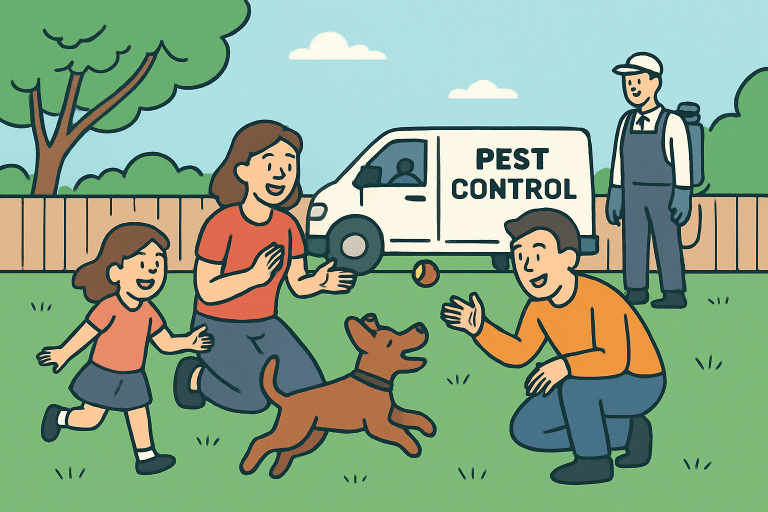Table of Contents
- Understanding the Flea Problem
- Signs of a Flea Infestation
- Benefits of Professional Flea Control Services
- What to Expect from a Flea Control Service
- Choosing the Right Flea Control Service
- Preventative Measures to Keep Fleas at Bay
- Conclusion
Understanding the Flea Problem
Fleas are a year-round problem due to their resilience in various environments, posing risks to both people and pets. They can quickly infest yards, causing discomfort through bites and spreading diseases like typhus and tapeworms. Children and pets are especially vulnerable, with pets often carrying fleas indoors. Tackling the problem effectively starts with understanding the specific habits of these tiny invaders—and having a strategic plan for outdoor pest management tailored to your unique local environment.
Effectively addressing flea problems outdoors requires a comprehensive strategy that targets hidden breeding areas, such as shaded spots, dense shrubs, and yard debris. Since infestations often start outside, focusing control efforts there helps prevent fleas from spreading indoors and protects both people and pets in outdoor spaces.
Signs of a Flea Infestation
Flea infestations can spiral out of control with surprising speed due to their prolific reproductive cycle. A single flea can lay dozens of eggs per day, resulting in thousands over its lifetime. Often, homeowners don’t realize there’s a problem until it has already grown, making it crucial to seek professional flea control near me as soon as signs appear to prevent further spread. The first indicators are usually subtle, manifesting as changes in the behavior of pets or family members that might be easy to overlook at first:
- Pets start scratching, biting, or licking themselves excessively, often leading to hair loss or irritated skin.
- Family members may notice small, red, itchy bites on their skin, particularly around the ankles, feet, or lower legs—areas likely exposed while walking outside or playing in the grass.
- Black flecks, known as flea dirt, begin to appear in pet beds, blankets, or other areas where furry companions tend to rest, indicating active feeding and breeding.
Fleas are notorious for seeking out hiding places not only in carpets and cracks, but in the tiniest nooks and crannies inside the home. However, the majority of infestations are fueled by emerging populations in the yard or garden. Early detection, especially in high-risk outdoor areas or during warm months, is crucial for preventing outbreaks from spreading further and for minimizing your risk of exposure to flea-borne diseases.
Benefits of Professional Flea Control Services
While store-bought sprays, traps, or powders might provide temporary relief, professional flea control services are designed to address the root of the problem and offer long-lasting solutions. These experts utilize advanced technology, proven techniques, and industry-leading products to target fleas at all stages of their life cycle—from stubborn eggs and larvae hidden in the soil to agile adult insects that hop between hosts. They approach the situation methodically and with safety in mind.
- Flea control specialists perform thorough inspections to uncover hidden nests, hot spots, and the primary sources feeding the infestation.
- They employ integrated pest management methods that break the flea life cycle, using eco-friendly or pet-safe treatments that minimize risk for children, animals, and the environment.
- These professionals also help design long-term preventive strategies tailored to your property, taking into account factors such as landscaping features, local climate patterns, and risk factors.
What to Expect from a Flea Control Service
The most effective flea control services employ a systematic and detailed approach designed to achieve maximum results. Typically, you’ll experience a step-by-step process:
- Initial assessment and inspection of both indoor and outdoor areas to accurately gauge the severity and potential sources of the infestation.
- The development and careful application of a customized treatment plan that targets fleas in all the places they may be hiding, both obvious and obscure.
- Comprehensive guidance on best practices for long-term prevention, including recommendations for yard maintenance, ongoing pet care routines, and monitoring strategies to catch early signs of recurrence.
Many service providers also offer follow-up visits to ensure the complete eradication of fleas and to apply maintenance treatments that prevent new infestations. This ongoing partnership proves especially valuable in regions with warm, humid climates or abundant vegetation, where outdoor flea populations can rebound swiftly if left unchecked.
Choosing the Right Flea Control Service
Not all pest management providers deliver the same quality of care, effectiveness, or integrity. As you compare companies, take time to evaluate their track record, customer reviews, and transparency about their products and techniques. Look for providers who:
- Hold established reputations and demonstrate proven results with customers in your community.
- Use products and treatment protocols that are safe for humans, pets, and the wider environment, while minimizing exposure to harsh chemicals whenever possible.
- Provide explicit guarantees of satisfaction or offer follow-up support, so you know the infestation will remain under control in the weeks and months ahead.
Preventative Measures to Keep Fleas at Bay
Consistent prevention is the cornerstone of effective, lasting flea management. Alongside the expertise of professional pest control, there are several practical steps you can take to create an environment that’s less inviting for fleas:
- Mow lawns frequently and trim shrubs or other plant growth to minimize the amount of cool, shaded habitat that fleas need for survival and development.
- Regularly clear away leaf litter, brush, and debris, removing the hiding and breeding grounds for flea eggs and larvae before a new problem begins.
- Work with your veterinarian to find the most effective, ongoing flea prevention products for your pets and tailor those solutions according to your animals’ health and the specific environment in which you live. According to the U.S. Environmental Protection Agency (EPA), it is also crucial to vacuum daily, especially in areas where pets sleep, and to pay special attention to cracks, baseboards, and basement spaces where fleas may reside.
Conclusion
A flea-free yard and home are possible through vigilance, proactive care, and the support of knowledgeable pest control professionals. With an integrated approach to outdoor management, the expertise of local services, and ongoing preventative measures, you can significantly reduce the risk of infestation. These efforts not only keep your family and pets safe and comfortable but also ensure you can continue to enjoy your outdoor spaces throughout the seasons. Take action early, choose respected experts, and make flea prevention a regular part of your household routine for lasting peace of mind.










